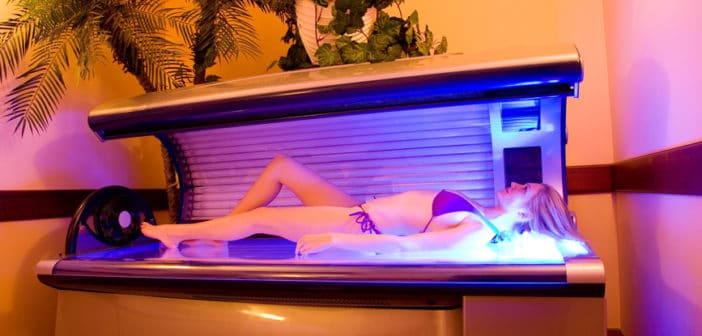 After two-and-a-half years of eating my feelings in sobriety, I’m finally stepping away from the Costco bag of peanut M&Ms. I’m running the stairs again and I refuse to give up on shorts altogether in this life. I’m also dating someone who says things like, “You’d look so hot with a tan,” and even though I’m thinking Fuck you, I actually agree with him. But here’s the thing, I am 200 years of Canadian/German/French. I am whiter than white. And so here I am, pledging to head half naked into summer on the heels of Skin Cancer Awareness month, with the image of this mom’s blistered face in my mind, warning me about the dangers of tanning. Just like Tawny Willoughby, I used to be the one in the tanning bed every other day. I worked at a hotel in high school, where employees could duck into the bed in the fitness center for free. I went every chance I got and, just like drinking, I didn’t feel like myself if I couldn’t indulge.
After two-and-a-half years of eating my feelings in sobriety, I’m finally stepping away from the Costco bag of peanut M&Ms. I’m running the stairs again and I refuse to give up on shorts altogether in this life. I’m also dating someone who says things like, “You’d look so hot with a tan,” and even though I’m thinking Fuck you, I actually agree with him. But here’s the thing, I am 200 years of Canadian/German/French. I am whiter than white. And so here I am, pledging to head half naked into summer on the heels of Skin Cancer Awareness month, with the image of this mom’s blistered face in my mind, warning me about the dangers of tanning. Just like Tawny Willoughby, I used to be the one in the tanning bed every other day. I worked at a hotel in high school, where employees could duck into the bed in the fitness center for free. I went every chance I got and, just like drinking, I didn’t feel like myself if I couldn’t indulge.
Is It Possible to Get Addicted to Tanning?
It looks like the answer is yes. We know ultraviolet light causes mice to produce endorphins and endorphins elevate mood. Can I go so far as to say that basking in the sun may create a state of euphoria? When I ask my Canadian countrymen, they say, “Well of course, eh, don’t’cha know.” (My niece literally talks like this.)
According to a study out of Wake Forest University, we also know that frequent tanners (those who tan eight to 15 times a month) can experience withdrawal symptoms, like nausea and the jitters, when they can’t get their fix—in much the same way a drug addict does. It would explain why someone like Justine Sheils continued to tan, even with a suspicious spot on her chest—“I just put a goggle over it”—almost losing both of her breasts to skin cancer in the process. Frankly, it would explain Donatella Versace.
Am I Dark Enough Yet?
There is no doubt that a tan makes us look leaner—it’s the science of light, contours and shadows. But why do we want to look leaner and more defined? Used to be that being pale and pudgy meant upper class—now nothing says cubicle like pale and pudgy, while a tan and a defined deltoid belies a life well lived. But how much is too much? If you don’t see anything wrong with a New Jersey mom taking her five-year-old daughter to the tanning bed, you have probably crossed the line. There’s a saying in recovery: one drink is too many, and a thousand is not enough. If you don’t think there is such a thing as too dark, you might be a tanorexic.
Is Tanorexia A Thing?
Apparently coined by David Sedaris in 2000, tanorexia is an apt amalgam of terms. Body dysmorphics are people who have a distorted view of their physical selves—people who think they are never skinny, muscular or tan enough. Interestingly, the process by which we get to these places—starvation, over-exercise and sun worship—all produce feelings of euphoria when we are engaging in them and intense anxiety when we are not.
Even though we know that prolonged exposure to UV radiation can lead to skin cancer, we are still heading out to the beach in droves, slathering ourselves in oil and making appointments at the tanning salon. Skin cancer might be the most common form of cancer in the US, but it remains a remote possibility in the face of the immediate relief that basking in the sun provides. A suntan is like a cigarette—potentially deadly, but not today.
Sponsored DISCLAIMER: This is a paid advertisement for California Behavioral Health, LLC, a CA licensed substance abuse treatment provider and not a service provided by The Fix. Calls to this number are answered by CBH, free and without obligation to the consumer. No one who answers the call receives a fee based upon the consumer’s choice to enter treatment. For additional info on other treatment providers and options visit www.samhsa.gov.




